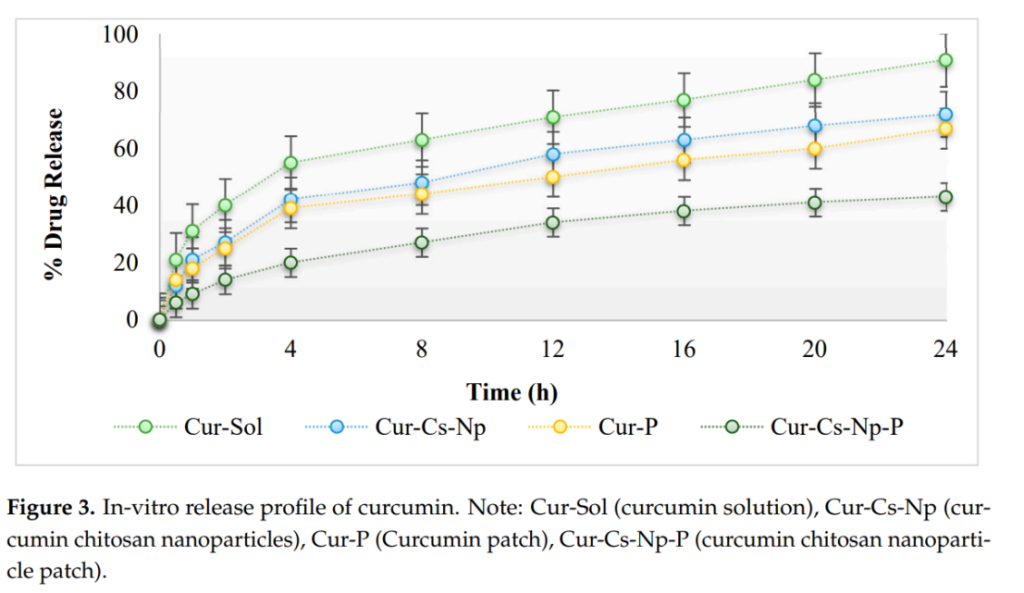
From Tradition to Innovation: A Historical Perspective
Curcumin, a compound derived from the Curcuma longa plant, has a centuries-long history as a therapeutic agent due to its anti-inflammatory, antioxidant, and antimicrobial properties. Despite its promise, the clinical application of curcumin has faced significant hurdles, including poor solubility, rapid metabolism, and low bioavailability. These limitations hinder its effectiveness, especially when delivered orally.
To address these challenges, recent research has turned toward topical delivery systems. Encapsulating curcumin in nanoparticles and incorporating it into transdermal patches offers a targeted solution for managing localized inflammation. This strategy bypasses traditional delivery obstacles, aiming to enhance drug retention and efficacy directly at the affected site. However, this novel approach comes with its own challenges, such as ensuring drug stability, optimizing skin permeability, and achieving controlled release.
The Team Behind the Breakthrough

This innovative research was conducted by a multidisciplinary team comprising Asif Nawaz, Muhammad Shahid Latif, Muhammad Khurshid Alam Shah, Tarek M. Elsayed, Saeed Ahmad, and Hamid Ali Khan. Their study, published in Gels on March 6, 2023, highlights the potential of ethyl cellulose-based patches containing chitosan-curcumin nanoparticles as a promising tool for inflammation management. The collaborative efforts span institutions in Pakistan and Malaysia, reflecting the global focus on advancing drug delivery technologies.
The study’s significance lies in its potential to overcome curcumin’s long-standing delivery challenges, paving the way for effective, scalable treatment options for inflammatory conditions.
Crafting the Future: A Look at the Methodology
The research employed a robust theoretical framework centered on the use of chitosan—a biocompatible polymer known for its permeability-enhancing properties. Curcumin-loaded nanoparticles were synthesized via ionic gelation, a technique that encapsulates the drug while preserving its bioactivity.
These nanoparticles were subsequently integrated into ethyl cellulose patches using a solvent evaporation method. The patches were designed to achieve controlled and prolonged drug release while maintaining flexibility and structural integrity.
To evaluate the efficacy of the formulations, the researchers conducted a series of analyses, including:
- FTIR Analysis: To assess compatibility between curcumin and the patch components.
- In Vitro and Ex Vivo Studies: To measure drug release, skin permeation, and retention using rat skin models.
- Anti-inflammatory Testing: To compare the performance of the nanoparticle patches with other formulations in reducing inflammation.
Results: Detailed Insights into Efficacy and Performance
The study yielded comprehensive data on the effectiveness of curcumin-loaded nanoparticles incorporated into ethyl cellulose-based patches. Below are the key findings from various experimental evaluations:
Improved Drug Retention and Permeation
Skin Retention: The patches showed superior drug retention compared to nanoparticles or patches alone. The curcumin-loaded nanoparticle patches retained a higher concentration of the drug in the skin due to the interaction between the positively charged chitosan nanoparticles and the negatively charged lipids in the skin. This interaction facilitated prolonged retention, critical for effective inflammation management.
Permeation Efficiency: While standalone nanoparticles displayed higher initial skin permeability, the patches moderated the drug release, ensuring a sustained and controlled delivery over 36 hours.
Controlled Drug Release
The drug release profile revealed a biphasic pattern. An initial burst of curcumin release occurred within the first 4 hours, attributed to the drug adsorbed on the nanoparticle surface. This was followed by a slower, sustained release of entrapped curcumin over 36 hours.

Quantitative Data: Approximately 70% of curcumin was released from nanoparticles within 24 hours, whereas the nanoparticle-incorporated patches extended the release period significantly.
Anti-inflammatory Activity
The anti-inflammatory efficacy was tested on rat models using paw edema as the primary indicator. Results demonstrated that the nanoparticle-loaded patches reduced paw inflammation more effectively and for a longer duration than nanoparticles or plain patches.
The maximum reduction in paw volume was observed with the patches, indicating better localization and prolonged drug action at the inflamed site.
Physicochemical Properties of Patches
The patches were smooth, flexible, and homogeneous, with a thickness range of 0.73–0.84 mm. They exhibited a pH of 5.9–6.3, aligning well with the skin’s natural pH.
Folding endurance exceeded 60 folds, ensuring durability during application. Drug content analysis showed that the patches contained 85.73% ± 2.49% of the intended curcumin, demonstrating consistent drug loading.

In Vitro and Ex Vivo Studies
In Vitro Drug Release: The patches displayed slower drug release compared to nanoparticles alone, with the controlled release attributed to the layered structure of the patch and polymer matrix.
Ex Vivo Permeation Studies: Using rat skin, permeation analysis revealed that while nanoparticles showed higher permeation initially, the patches ensured a gradual drug release, with maximum drug retention observed in the deeper layers of the skin.
These detailed results showcase the potential of curcumin-loaded nanoparticle patches as a novel and efficient solution for localized inflammation management, offering controlled drug release, enhanced retention, and superior anti-inflammatory effects.
Bridging the Gap: Implications and Next Steps
The incorporation of chitosan-curcumin nanoparticles into patches offers a novel and effective approach to addressing localized inflammation. This advancement not only holds promise for conditions like arthritis and dermatitis but also represents a scalable solution for broader dermatological and pharmaceutical applications.
However, the study acknowledges certain limitations, such as its reliance on animal models, which may not fully replicate human skin behavior. Future research should focus on clinical trials to validate these findings and explore additional applications for other inflammatory and skin-related disorders.
Conclusion: Toward a Brighter Therapeutic Horizon
This study marks a pivotal step in curcumin delivery technology. By leveraging the unique properties of chitosan nanoparticles and ethyl cellulose patches, the researchers have created a platform that could revolutionize inflammation management. The findings not only enhance the clinical utility of curcumin but also open new pathways for innovation in drug delivery science.
With further development and validation, this technology could become a cornerstone in the treatment of localized inflammatory conditions, bringing hope to patients worldwide.
Reference:
Nawaz, Asif, et al. “Formulation and characterization of ethyl cellulose-based patches containing curcumin-chitosan nanoparticles for the possible management of inflammation via skin delivery.” Gels 9.3 (2023): 201.
